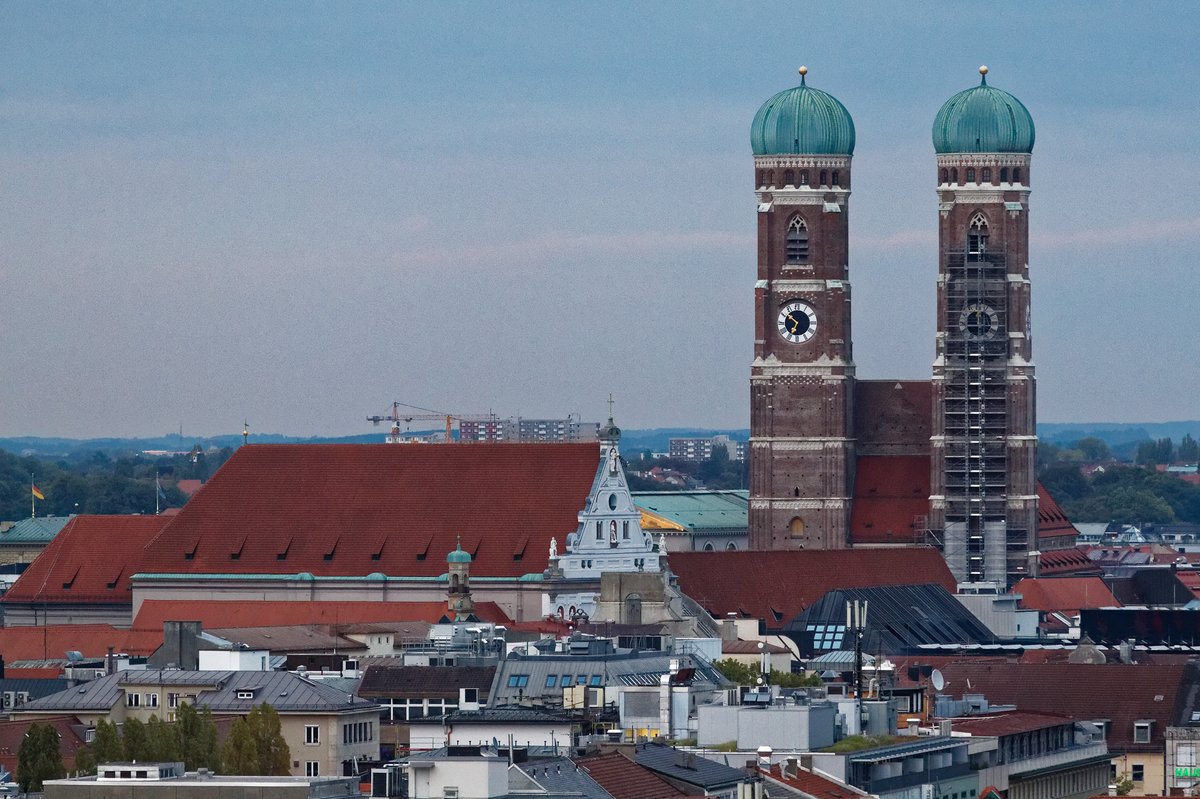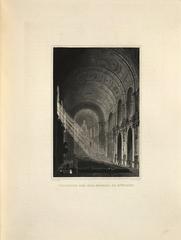
St. Michael’s Church Munich: Visiting Hours, Tickets, and Travel Guide
Date: 14/06/2025
Introduction to St. Michael’s Church in Munich
St. Michael’s Church (Michaelskirche), located in the heart of Munich, is a masterpiece of Renaissance architecture and a vital symbol of Bavarian history. Built between 1583 and 1597 under the patronage of William V, Duke of Bavaria, the church was conceived as a bastion of the Catholic Counter-Reformation and a dynastic monument for the House of Wittelsbach. As the first and largest Renaissance church north of the Alps, its monumental façade and vast barrel-vaulted nave mark significant departures from medieval traditions, positioning St. Michael’s as a pivotal structure in European architectural history (St. Michael’s Official Site; Absolute Munich).
The church’s elaborate artistic program, including frescoes, stucco, and Hubert Gerhard’s iconic bronze statue of Archangel Michael, encapsulates Counter-Reformation ideals and Bavarian dynastic pride. St. Michael’s also serves as the royal crypt for the Wittelsbach family, housing the tombs of prominent figures such as Ludwig II and William V (Pfistermühle Magazine; Introducing Munich).
Today, St. Michael’s is open to the public, offering free admission to the main church and a modest fee for the crypt. Its central location near Neuhauser Straße, proximity to other historic sites, and accessibility features make it an essential stop for anyone exploring Munich’s rich heritage (St. Michael’s Official Site; muenchen.de).
Table of Contents
- Origins and Foundation
- Architectural Significance
- Notable Historical Events
- Visiting Hours and Tickets
- Travel Tips
- Nearby Attractions and Special Events
- Architectural Evolution and Restoration
- Symbolism and Artistic Heritage
- Frequently Asked Questions (FAQ)
- Summary and Visit Tips
Origins and Foundation
St. Michael’s Church emerged during a critical juncture in Bavarian history, tightly linked to the Counter-Reformation. In 1556, Albert V, Duke of Bavaria, permitted the Jesuits to establish a presence in Munich, leading to the founding of the Wilhelmsgymnasium and, eventually, St. Michael’s Church (Wikipedia). The foundation stone was laid in 1583, with William V (“the Pious”) as its primary patron. The church was envisioned not only as a spiritual center but also as a powerful statement against the spread of Protestantism, necessitating the demolition of many medieval houses to make way for its unprecedented scale (Guided Tours).
Architectural Significance
Renaissance Innovation North of the Alps
St. Michael’s is celebrated as the first and largest Renaissance church north of the Alps, setting a precedent for ecclesiastical architecture throughout southern Germany (Spotting History). Its design, influenced by the Church of the Gesù in Rome, reflects the ideals of the Jesuit order and the ambitions of William V. Rejecting the traditional eastward orientation, the church was integrated into the urban fabric, with its monumental façade facing Neuhauser Straße (St. Michael’s Official Site).
The Monumental Façade
The multi-tiered façade features statues of fifteen Bavarian rulers, with Christ at the apex, symbolizing the church’s religious and dynastic significance (Munich.de). At its center is Gerhard’s bronze Archangel Michael, a powerful emblem of Catholic triumph (Introducing Munich).
The Barrel Vault: Engineering Feat
The nave’s barrel vault, measuring 20 meters wide and 28.5 meters high, was the largest of its kind outside Italy at its completion—a remarkable engineering feat (Wikipedia). The vault remains a model for later Baroque churches in the region (Absolute Munich).
Interior Decoration and Symbolism
Inside, the church is adorned with stucco, frescoes depicting Christ’s life, triumphal arches, and the renowned “Annunciation” altarpiece by Peter Candid. The decor powerfully communicates the spirit and message of the Counter-Reformation (Munich.de).
The Royal Crypt
Beneath the choir, the crypt houses members of the Wittelsbach dynasty, including William V, Maximilian I, Ludwig II, and Otto (Pfistermühle Magazine). The crypt is accessible to visitors for a small fee (Absolute Munich).
Absence of a Church Tower
The church’s original tower collapsed soon after construction, and was never rebuilt, resulting in a unique silhouette that emphasizes the nave and façade (Absolute Munich).
Notable Historical Events
St. Michael’s quickly became a Jesuit focal point following its consecration in 1597. After the Jesuit suppression in 1773, the church passed to the Wittelsbachs, and following the end of the monarchy, to the Free State of Bavaria. In 1921, Jesuit pastoral care was restored (St. Michael’s Official Site).
The church suffered severe damage during WWII, including the collapse of the barrel vault. Restoration began immediately post-war, with major efforts in the 1980s and continuing façade work since 2009, ensuring the church’s preservation for future generations (St. Michael’s Official Site).
St. Michael’s Church Munich: Visiting Hours and Tickets
- Monday to Saturday: 9:00 AM – 6:00 PM
- Sunday and Public Holidays: 1:00 PM – 6:00 PM
Admission to the main church is free; entry to the royal crypt requires a small fee (around €2–€3 as of 2025). Special events, guided tours, and concerts may require tickets, which are available online or at the church (St. Michael’s Official Site).
Wheelchair access is provided, with ramps and assistance upon request. Always check the official website for the latest updates on hours, event schedules, and health guidelines.
Travel Tips for Visiting St. Michael’s Church Munich
- Best Times: Early mornings or late afternoons on weekdays are quietest.
- Getting There: Located on Neuhauser Straße, the church is near U-Bahn stations Marienplatz and Sendlinger Tor.
- Tours: Guided tours and audio guides in multiple languages are available.
- Photography: Allowed without flash; tripods need permission.
- Nearby Attractions: Combine with visits to Marienplatz, the Residenz, Frauenkirche, and Viktualienmarkt.
Nearby Attractions and Special Events
St. Michael’s hosts concerts, choir performances, organ recitals, and exhibitions of religious art (AwayMag). The church is a stop on most walking tours of Munich’s historic center, with many top attractions—Frauenkirche, St. Peter’s Church, Viktualienmarkt—within easy walking distance.
Architectural Evolution and Restoration
The church has seen several major restorations, particularly after WWII and in the early 1980s. Recent work includes façade repainting and statue restoration, maintaining both its structural integrity and visual magnificence (Pfistermühle Magazine).
Symbolism and Artistic Heritage
St. Michael’s Counter-Reformation message is evident in its architecture and art: from triumphal arches and frescoes of Christ’s life to the statuary of Bavarian rulers (Munich.de). Masterpieces like Candid’s “Annunciation” and Gerhard’s angel sculpture narrate Munich’s religious and cultural journey.
Frequently Asked Questions (FAQ)
Q: What are the visiting hours?
A: Monday–Saturday: 9:00 AM–6:00 PM; Sunday and public holidays: 1:00 PM–6:00 PM.
Q: Is there an entrance fee?
A: Main church entry is free; the royal crypt requires a small ticket.
Q: Are tours available?
A: Yes, guided and audio tours in multiple languages can be booked online or onsite.
Q: Is the church accessible for those with disabilities?
A: Yes, with ramps and assistance available.
Q: What nearby attractions should I visit?
A: Marienplatz, Frauenkirche, St. Peter’s Church, Viktualienmarkt, and the Residenz are all close by.
Summary and Visit Tips
St. Michael’s Church Munich stands as a testament to Renaissance innovation, Bavarian heritage, and spiritual resilience. Its barrel vault, monumental façade, and dynastic crypt offer a rich tapestry of art, history, and faith. With generous opening hours, free entry, and a central location, the church is an essential stop for anyone exploring Munich’s historical heart (St. Michael’s Official Site; Pfistermühle Magazine).
For an enhanced visit, use the Audiala app for audio guides and up-to-date event info, and consult the church’s official website for current details. Respect the worship space, arrive early, and take time to enjoy the church’s artistry and peaceful atmosphere.
References and Further Reading
- St. Michael’s Church, Munich – Wikipedia
- St. Michael’s Official Site
- Spotting History
- Munich.de
- Guided Tours at St. Michael’s
- Absolute Munich Guide
- Pfistermühle Magazine
- Introducing Munich
- AwayMag
- Triphobo – St. Michael’s Church
- The Catholic Travel Guide
- Rick Steves Community
- Timeout Munich






































































































